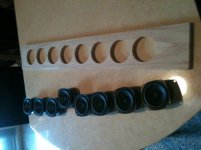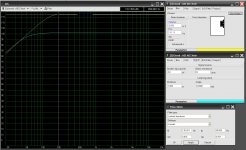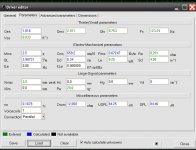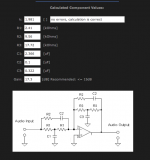If you wired each set of 4 in a 2x2 configuration and then used the two sets with a crossover, Then Yes, It would be an 8 ohm configuration for the system as a whole.
However I would configure the drivers with a WMTMW configuration.
What you have shown is WTM from the bottom up.
jer
However I would configure the drivers with a WMTMW configuration.
What you have shown is WTM from the bottom up.
jer
Last edited:
Yes! So I am indeed learning and getting it right! 
WWMMTMMWW, that's what I meant, but for the sake of clarity, I just went with that simple design...
Looking at those little 3"... there's not a lot of space from the side of the basket to the outer rim to mount them. A few mm at best! I'll need a precision cut. And the magnet is bigger than the woofer! Strong magnets too!
WWMMTMMWW, that's what I meant, but for the sake of clarity, I just went with that simple design...
Looking at those little 3"... there's not a lot of space from the side of the basket to the outer rim to mount them. A few mm at best! I'll need a precision cut. And the magnet is bigger than the woofer! Strong magnets too!
I am a believer!
So, just for kicks, I took one driver out and listened... meh... kinda sounds like a cheap Radio-Shack-one-speaker radio.
So, wired up all my 8 drivers to a quick open baffle I made (can't believe I got the wiring right on my first try!) and... wow, I'm starting to like it! Now, we are moving into the good stuff!
But, the OB is indeed not working. Too much cancellation and it just doesn't sound right... I can hear I am on the right track, but just not there yet. Also, I don't think I'll need tweeters with those little 3". The highs are there. Will probably need EQing.
So now, my plan is to get another 16 drivers, adding to my 16 I already have, so I will be at a total of 16 for each tower. Wired up in 4x4, it will stay at 8 Ohms. (with 8 drivers I am at 6.4 Ohms now)
Starting to look like a short array?
Been reading around here and I believe each series of 4 drivers will need to be sealed into their own space. My previous question stands. How do I know how much volume I will need for each series of 4? I couldn't find anything yet...
Also, should I go ported or sealed with a short array of 16 drivers?
So, just for kicks, I took one driver out and listened... meh... kinda sounds like a cheap Radio-Shack-one-speaker radio.
So, wired up all my 8 drivers to a quick open baffle I made (can't believe I got the wiring right on my first try!) and... wow, I'm starting to like it! Now, we are moving into the good stuff!
But, the OB is indeed not working. Too much cancellation and it just doesn't sound right... I can hear I am on the right track, but just not there yet. Also, I don't think I'll need tweeters with those little 3". The highs are there. Will probably need EQing.
So now, my plan is to get another 16 drivers, adding to my 16 I already have, so I will be at a total of 16 for each tower. Wired up in 4x4, it will stay at 8 Ohms. (with 8 drivers I am at 6.4 Ohms now)
Starting to look like a short array?
Been reading around here and I believe each series of 4 drivers will need to be sealed into their own space. My previous question stands. How do I know how much volume I will need for each series of 4? I couldn't find anything yet...
Also, should I go ported or sealed with a short array of 16 drivers?
Attachments
Run them through a free programme like WinISD or similar for the suitable Q -use the pro. version so you can adjust damping in the box since it otherwise assumes acoustic suspension sans damping.
Depends how you're planning to Eq them, but I'd be inclined toward sealed in any case. You don't need separate volumes, but something to break up the longituding standing wave is no bad thing, so solid bracing should do the job nicely.
Depends how you're planning to Eq them, but I'd be inclined toward sealed in any case. You don't need separate volumes, but something to break up the longituding standing wave is no bad thing, so solid bracing should do the job nicely.
Winlsd seems to only like a sealed configuration for your driver with the data from the sheet that you posted.
A cabinet volume of 1.5 to 3.0 cubic feet is good.
The program just kicks out the data for a vented alignment and shows no real benefit for a ported system.
In the screenshot that I have included, I have set the power levels for an Xmax of 3mm at 30Hz with a box volume of 2.020 cubic feet.
The power level set for the Blue SPL curve is 3.0 watts for a SPL of 101.16db.
This includes a linkwitz filter as shown that is calculated by the program.
Except, I did change the low frequency setting to 50Hz instead of the normal 20Hz as the drivers excursion just shoots through the roof at 20Hz.
The power level for the Yellow curve is set at 123.4 watts for the same conditions but without the Linkwitz filter for an SPL of 117.458db at 200Hz.
This is only 7.7125watts per driver.
It will be a pretty impressive system with all 32 drivers using only a 50 to 120 watt per channel amplifier!!!
The curves do suggest to use a separate subwoofer with the system.
Although, You may just get all of the sound you will need on a few watts using a linkwitz transform filter.
Cheers!!!
jer
A cabinet volume of 1.5 to 3.0 cubic feet is good.
The program just kicks out the data for a vented alignment and shows no real benefit for a ported system.
In the screenshot that I have included, I have set the power levels for an Xmax of 3mm at 30Hz with a box volume of 2.020 cubic feet.
The power level set for the Blue SPL curve is 3.0 watts for a SPL of 101.16db.
This includes a linkwitz filter as shown that is calculated by the program.
Except, I did change the low frequency setting to 50Hz instead of the normal 20Hz as the drivers excursion just shoots through the roof at 20Hz.
The power level for the Yellow curve is set at 123.4 watts for the same conditions but without the Linkwitz filter for an SPL of 117.458db at 200Hz.
This is only 7.7125watts per driver.
It will be a pretty impressive system with all 32 drivers using only a 50 to 120 watt per channel amplifier!!!
The curves do suggest to use a separate subwoofer with the system.
Although, You may just get all of the sound you will need on a few watts using a linkwitz transform filter.
Cheers!!!
jer
Attachments
Last edited:
Bessel? Who's he? I guess it's time to hit Google...
In the mean time, how do I design a cabinet for an array?
Most cabinet calculators do so for a single driver... So how do I convert the data into a line source cabinet?
Bessel Array; it's a way to wire up a line array to fool us into perceiving a single point source with the trade-off that efficiency is only whatever a single driver is.
There's also a way to make a line array into a stereo speaker, so I imagine some [all?] of the consumer soundbars are Bessel Arrays: https://www.google.com/search?q=bes...j7&sourceid=chrome&espv=210&es_sm=93&ie=UTF-8
For the basic simming of multiple drivers, just increase the Vas spec by the number of drivers required to get the net volume [Vb] and vent design [if desired].
GM
Thanks GM, I've read a bit about Bessel Array, but I think I'll keep it simple for my first run...
jer, thanks for the calculations, you got me excited. Sounds like good news. I have an older version (alpha, 0.5-something) of Winlsd on my computer, but couldn't get any of that info you showed me.
Learning about the Linkwitz filter as I write. Best way to implement it? MiniDSP, Behringer DEQ2496 or homemade circuit?
I guess I'll need to upgrade my receiver as well, since I do not have pre-outs on my current receiver/amp.
jer, thanks for the calculations, you got me excited. Sounds like good news. I have an older version (alpha, 0.5-something) of Winlsd on my computer, but couldn't get any of that info you showed me.
Learning about the Linkwitz filter as I write. Best way to implement it? MiniDSP, Behringer DEQ2496 or homemade circuit?
I guess I'll need to upgrade my receiver as well, since I do not have pre-outs on my current receiver/amp.
Here is the data I used to create the model.
I have also included the file in a ZIP so that you can just add it to your Winlsd drivers folder.
Since Winlsd checks all of the parameter the only one I changed was the Qes by erasing it and letting Winlsd to recalculate it or else it won't let you save the file.
I can't tell how to go about using the digital stuff but implementing the filter with a single dual (or quad) opamp would be by far the cheapest method to use.
I am in the process of designing a preamp and active crossover design for my Desktop ESL system and it requires such a filter.
I am think about implementing the filter with a boost and cut function so that I can adjust the level of low end boost with the overall power level.
The Higher the power level the lower the low end boost will be to keep the high excursions at frequency's lower than 40Hz or 50Hz under control for my 5.25" woofer.
jer
I have also included the file in a ZIP so that you can just add it to your Winlsd drivers folder.
Since Winlsd checks all of the parameter the only one I changed was the Qes by erasing it and letting Winlsd to recalculate it or else it won't let you save the file.
I can't tell how to go about using the digital stuff but implementing the filter with a single dual (or quad) opamp would be by far the cheapest method to use.
I am in the process of designing a preamp and active crossover design for my Desktop ESL system and it requires such a filter.
I am think about implementing the filter with a boost and cut function so that I can adjust the level of low end boost with the overall power level.
The Higher the power level the lower the low end boost will be to keep the high excursions at frequency's lower than 40Hz or 50Hz under control for my 5.25" woofer.
jer
Attachments
Last edited:
Read what Roger Russel (formerly of McIntosh) has to say about the design and experience of his $19000 line array system (the IDS25) (just google his name to find his fun website).
It seems that there is great benefit by having the line array extend all the way (very close anyway) to both the floor and the ceiling. The reflections off those surfaces effectively extend the line several times in each direction, thereby filling in comb filter cancellations better, and dealing better with listening room acoustics in general. He gets 25 three inch drivers to be somewhat acoustically flat down to 20HZ. I'd only go for 30HZ myself.
If you add subwoofers that go above 80HZ, then you've thrown away a big feature of how line arrays work with room acoustics. Typical rooms usually have major acoustic problems in the 80 - 300HZ region (due to the size of the wavelengths and limited room reflections in that frequency region - so cancellations don't get filled in by other comb filter mechanisms), that can be significantly lessened by a line array. I'd go with the 8 ohm Vifa TC9 three inch drivers myself, and regardless of which driver you use, a line array needs substantial EQ to end up acoustically flat, with is best done actively (ahead of the poweramps).
It seems that there is great benefit by having the line array extend all the way (very close anyway) to both the floor and the ceiling. The reflections off those surfaces effectively extend the line several times in each direction, thereby filling in comb filter cancellations better, and dealing better with listening room acoustics in general. He gets 25 three inch drivers to be somewhat acoustically flat down to 20HZ. I'd only go for 30HZ myself.
If you add subwoofers that go above 80HZ, then you've thrown away a big feature of how line arrays work with room acoustics. Typical rooms usually have major acoustic problems in the 80 - 300HZ region (due to the size of the wavelengths and limited room reflections in that frequency region - so cancellations don't get filled in by other comb filter mechanisms), that can be significantly lessened by a line array. I'd go with the 8 ohm Vifa TC9 three inch drivers myself, and regardless of which driver you use, a line array needs substantial EQ to end up acoustically flat, with is best done actively (ahead of the poweramps).
Thanks Bob, I've stumbled onto Roger Russel's website in my ongoing search.
Trouble in this instance is I can't go all the way to the floor... the living room shelf these will be rested on is just too wide. In 15 years, when we retire, I will regain that space, but for now, I have to live with the house limitations.
With 16 drivers, I will get closer to the ceiling, which is cement, so I may (or may not) get enough "mirror" effect... only way will be to try it.
Trouble in this instance is I can't go all the way to the floor... the living room shelf these will be rested on is just too wide. In 15 years, when we retire, I will regain that space, but for now, I have to live with the house limitations.
With 16 drivers, I will get closer to the ceiling, which is cement, so I may (or may not) get enough "mirror" effect... only way will be to try it.
I sympathize with your dilemma about how to use line array active EQ in your system. I bought a Yamaha receiver that has poweramps for at least 5 channels of speakers, but I picked one that also has preamp outputs, so I could run the signals through a 4 pole 3 way active crossover and active woofer EQ, on the way to external poweramps. Unfortunately there were no inputs to just the poweramp section of the Yamaha, so they couldn't be used.
Digital connections between sources and preamps/poweramps may be technically more accurate, but analog is pretty darn good for audio in my opinion. I know what's going on better with analog. With digital and all the different sometimes proprietary standards I'm never sure what's really going on, or what's compatible with what, so I try to avoid that.
Without the preamp outputs on my receiver, I'd be stuck with whatever functions the receiver offers. If there is a "tape loop" type function on you receiver (or whatever your main control unit is called), you could use that for the line array active EQ, but I'm not sure many receivers have those anymore.
If there's no way to hook active EQ into your system ahead of the power amps, you might want to consider a different speaker design, or getting a different preamp/poweramp setup.
Although the line array EQ can theoretically be done in the speaker crossover passively, it would necessarily reduce the efficiency of the speakers by at least 10dB. A 100 watt poweramp would be effectively reduced to being a 13 watt amp (roughly).
Digital connections between sources and preamps/poweramps may be technically more accurate, but analog is pretty darn good for audio in my opinion. I know what's going on better with analog. With digital and all the different sometimes proprietary standards I'm never sure what's really going on, or what's compatible with what, so I try to avoid that.
Without the preamp outputs on my receiver, I'd be stuck with whatever functions the receiver offers. If there is a "tape loop" type function on you receiver (or whatever your main control unit is called), you could use that for the line array active EQ, but I'm not sure many receivers have those anymore.
If there's no way to hook active EQ into your system ahead of the power amps, you might want to consider a different speaker design, or getting a different preamp/poweramp setup.
Although the line array EQ can theoretically be done in the speaker crossover passively, it would necessarily reduce the efficiency of the speakers by at least 10dB. A 100 watt poweramp would be effectively reduced to being a 13 watt amp (roughly).
Good class D amps are so inexpensive nowadays that you can't let yourself get bogged down and tied to an amp or receiver that doesn't have line in/out.
IRS2092 type self-oscillating external MOSFET class D amps can put out any level of power (from 70 watts to 2kW) with low THD. If you only need 50 watts/ch the TPA3116D2 is excellent ($20 ea). For power shading maybe several smaller class D amps and a fan-out can work well.
IRS2092 type self-oscillating external MOSFET class D amps can put out any level of power (from 70 watts to 2kW) with low THD. If you only need 50 watts/ch the TPA3116D2 is excellent ($20 ea). For power shading maybe several smaller class D amps and a fan-out can work well.
- Status
- This old topic is closed. If you want to reopen this topic, contact a moderator using the "Report Post" button.
- Home
- Loudspeakers
- Full Range
- Short Line Array (line source) build



